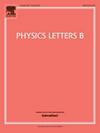Superradiant bound states of charged scalars around Melvin-Kerr black holes
IF 4.5
2区 物理与天体物理
Q1 ASTRONOMY & ASTROPHYSICS
引用次数: 0
Abstract
We investigate superradiant bound states of a charged, massive scalar in the Melvin-Kerr spacetime, a rotating black hole immersed in an external magnetic field, working in the weak-field regime . We adopt a gauge with at spatial infinity, thereby removing spurious artifacts in the limit, and show that the Klein–Gordon equation separates so that the radial dynamics can be cast in Schrödinger-like form. The effective potential exhibits a universal large- tail with both and corrections controlled by the magnetic coupling . Using a far-zone Whittaker reduction we derive a simple trapping criterion that captures when a potential well forms outside the horizon. Combining this with the magnetically shifted superradiant band at the horizon and with the decay requirement at infinity yields an instability window in which superradiantly amplified quasi-bound states exist. The criterion reduces continuously to the standard Kerr bound in the limit , which provides a nontrivial consistency check. Numerical profiles of the effective potential illustrate parameter sets with and without trapping, clarifying how the magnetic field and the azimuthal number compete to enhance or to quench the instability.
梅尔文-克尔黑洞周围带电标量的超辐射束缚态
我们研究了Melvin-Kerr时空中带电大质量标量的超辐射束缚态,这是一个沉浸在外磁场中的旋转黑洞,工作在弱场区bM≪1。我们在空间无穷远处采用At→0的规范,从而消除了在a→0极限处虚假的1/a伪像,并表明Klein-Gordon方程可以分离,因此径向动力学可以以Schrödinger-like形式投射。有效电位呈现出普遍的大r尾,由磁耦合bmq控制1/r和1/r2修正。利用远区Whittaker约简,我们得出了一个简单的捕获标准,可以捕捉到潜在井何时在层位外形成。将此与视界处的磁移超辐射带和无穷远处的衰变要求结合起来,可以产生一个不稳定窗口,在该窗口中存在超辐射放大的准束缚态。该准则连续化简为极限b→0处的标准Kerr界,提供了一种非平凡的一致性检验。有效电位的数值剖面说明了有和没有捕获的参数集,阐明了磁场和方位角数如何相互竞争以增强或消除不稳定性。
本文章由计算机程序翻译,如有差异,请以英文原文为准。
求助全文
约1分钟内获得全文
求助全文
来源期刊

Physics Letters B
物理-物理:综合
CiteScore
9.10
自引率
6.80%
发文量
647
审稿时长
3 months
期刊介绍:
Physics Letters B ensures the rapid publication of important new results in particle physics, nuclear physics and cosmology. Specialized editors are responsible for contributions in experimental nuclear physics, theoretical nuclear physics, experimental high-energy physics, theoretical high-energy physics, and astrophysics.
 求助内容:
求助内容: 应助结果提醒方式:
应助结果提醒方式:


